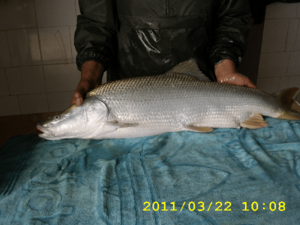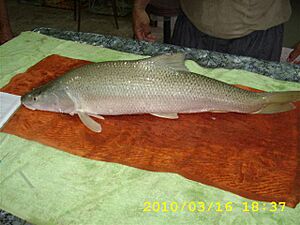Mangar (fish) facts for kids
Quick facts for kids Mangar (fish) |
|
|---|---|
 |
|
 |
|
| Conservation status | |
| Scientific classification | |
| Genus: |
Luciobarbus
|
| Species: |
esocinus
|
| Synonyms | |
|
|
The Mangar (also called the pike barbel) is a very large fish. Its scientific name is Luciobarbus esocinus. This amazing fish lives in the Tigris–Euphrates river system. You can find it in countries like Iran, Iraq, Syria, and Turkey.
People have valued the Mangar for a long time as a food fish. However, its numbers are now dropping. This is because too many are being caught, and their homes (habitats) are being damaged. Because of this, the Mangar is now considered a vulnerable animal. Ancient drawings from 1500–1000 BC even show Assyrian priests wearing Mangar skins!
Contents
About the Mangar's Name
The Mangar is a special fish. It is the main example for its group, called Luciobarbus. This group was named by Heckel in 1843. The Mangar's scientific name means "pike-like pike-barbel". This name comes from the northern pike, which is a fish known as Esox lucius.
What Does the Mangar Look Like?
The Mangar is one of the biggest cyprinid fish in the world. It can grow up to 2.3 m (7.5 ft) long. That's about 7.5 feet! It can also weigh up to 140 kg (310 lb), which is about 300 pounds. A more common size is 1–1.5 m (3.3–4.9 ft) long and 60 kg (130 lb) in weight. This fish can live for at least 17 years.
The Mangar has a very large head. Its mouth does not have teeth. Instead, it has four whiskers, called barbels, around its mouth. Its body is silvery and covered with small scales. It has one fin on its back (dorsal fin). It also has two fins on its sides (pectoral fins) and two fins on its belly (ventral fins). The fin near its tail (anal fin) and its tail itself often have yellowish colors.
Where the Mangar Lives and What It Does
The Mangar lives in the drainage basins of the Euphrates and Tigris rivers. These rivers flow through Iran, Iraq, Syria, and Turkey. Adult Mangar fish prefer to stay in large bodies of water. This includes big rivers and reservoirs. When it's time to lay eggs (spawn), they swim to smaller streams.
The Mangar eats many different things. It has been seen eating tiny water animals called zooplankton. It also eats small creatures without backbones, known as invertebrates. Bigger Mangar fish will even eat other fish and birds! Sometimes, they also eat tiny water plants called phytoplankton. Fish usually make up about half of what the Mangar eats.
Protecting the Mangar
The Mangar is currently listed as a Vulnerable animal by the IUCN. This means it is at risk of becoming endangered. We don't have exact numbers for how many Mangar fish are left. However, reports show that catches have dropped a lot in recent years. Many people believe that most Mangar populations are being caught too much.
Even though some places still have many Mangar fish, people are worried. Catching too many Mangar for food is a big problem. Scientists are trying to help. The Mangar has been successfully raised in special tanks. This means it could be grown on farms in the future. This process is called aquaculture. It could help protect the wild Mangar population.


